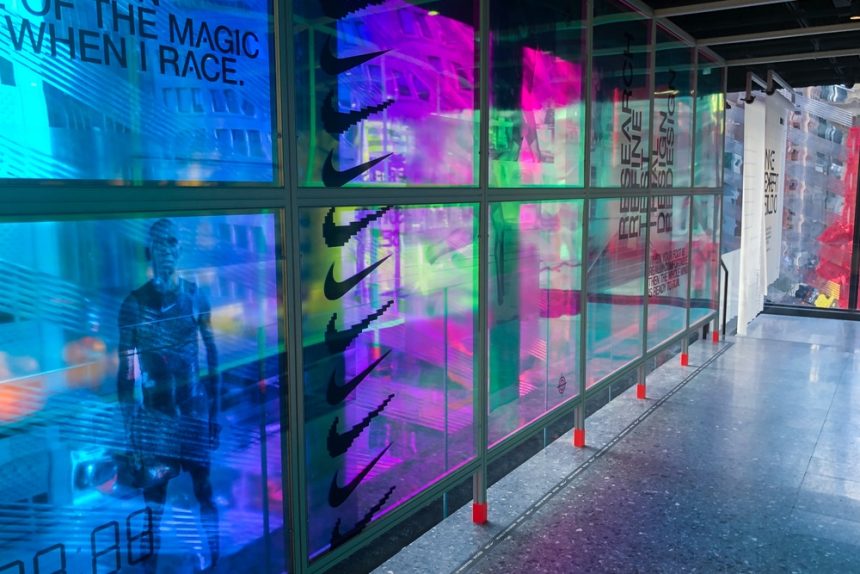 Image credit: Christopher Lyzcen / Shutterstock.com
Image credit: Christopher Lyzcen / Shutterstock.com
Splashing the cash on flagship brand experiences isn’t a new move for any modern retailer. But Nike’s new highly customised shopping experience is a good example of this trend and one that reaches a new level of commitment to the idea of personalisation.
Nike’s massive Fifth Avenue store offers customers the advanced level of immersive branding you’d expect from a flagship. But the Nike House of Innovation 000 takes things to the next level when it comes to crafting a personalised brand experience. Customers have the chance to customise every aspect of their trainers and the option to get the help of a personal shopper to do it.
The sportswear brand has used technology to unite the online and offline experiences and offer a seamless retail experience. It’s also offering an unprecedented level of ‘craftsman’ services in-store, including dyeing, printing, embroidery and lasering.
It’s an approach that’s already been tried in Japan, albeit with much smaller floor space. Nike’s New York flagship personalisation experience is attempting to do this at a much larger scale.
It’s not unusual for brands to invest in cultivating a special offering for their most loyal fans. In this case, Nike is catering to its Nike Plus members, who can enjoy extra services and exclusive access. Sportswear and fashion are at an unprecedented level of intersection at present thanks to runway and social trends such as athleisure.
Nike’s new store is an attempt at acing this new trend of fashionable trainers, clawing back some territory from major rival Adidas who are doing well in this space thanks to some recent winning fashion collaborations.
RELATED: How the Wellness Phenomenon is Influencing Fashion Globally
We’ve known for some time that customisation is now a big trend in fashion and other industries. Nike’s store is merely a confirmation of that reality – but it’s perhaps one that takes this concept to its extremes. Smaller sportswear brands are likely to look at this venture with some trepidation, as it represents a high investment in the brand experience and huge commitment to evolving the brand positioning.
Technology enhances the experience
Technology plays a large part in Nike’s new venture and it’s worth observing how the brand is using tech in an integrated way throughout the customer experience. Customers that have the Nike app installed can use it throughout their in-store experience. The app can be used to scan barcodes and pay for items, with customers effectively serving themselves.
It’s important to note that the high use of technology doesn’t mean there are no staff on hand. Although customers can check out by themselves using the Nike app, brand representatives are there to enhance the experience.
That’s a changed role for staff working the floor. The one-to-one shopping consultation on offer means that staff need to have more engaged interactions with each customer and more training.
Luxury-like
What’s emerging from this analysis is that Nike is essentially offering the type of service and experience usually associated with luxury brands. This includes one-to-one attention from shopping consultants, courier services and an immersive brand experience.
The difference is that Nike is trying to do this at quite a large scale – 68,000 square feet in fact. The only way this is practical is by using technology. Customers can completely self-serve in store, buying ready-made items or demand the highest level of attention from sales associates.
Nike’s store is also an experiment in trying to resolve a common retail conundrum – how to reconcile the online and offline experience. Like major bricks-and-mortar retailer Walmart, the brand is using a proprietary app to tie in online and offline activity from its regular customers. It’s a way to identify shoppers and serve them more effectively. We’re likely to see big growth in this area in future with Nike being just the latest brand to make moves in this space.

Proprietary apps are increasingly being used by brands to tie in online and offline sales. Using data such as location to deliver offers and discounts to users to redeem in their local store in one such example.
Walmart’s particular success was at offering flexibility. It recognised that customers may like to engage online, but don’t always have internet access. It also recognised that even though customers shop online they may still prefer to pay in cash. And it lets customers choose whether to get items delivered to their home or to collect in-store.
Nike’s in-store experience is similarly flexible. Customers can demand the highest level of attention possible or avoid human contact entirely and just shop using their mobile phone in-store.
With retail facing a challenging market, consumers increasingly more interested in experiences than in owning things and with the perpetual challenge from online commerce, brands are obliged to innovate in order to survive.
Nike’s certainly made a bold stab at adapting to the new world of retail and capturing customer attention. Nike’s responded to new technological developments and change in the sportswear sector all in one fell swoop.
It’s luxury brands that perhaps have the most to learn from Nike’s experiment. It clearly is possible to customise the customer experience and to do it at scale. As AI becomes increasingly sophisticated we’re likely to see more brands using it to offer personalisation of products and services. Nike’s made a bold move in New York but it’s likely this is just a sign of the way the retail sector is going in future.














